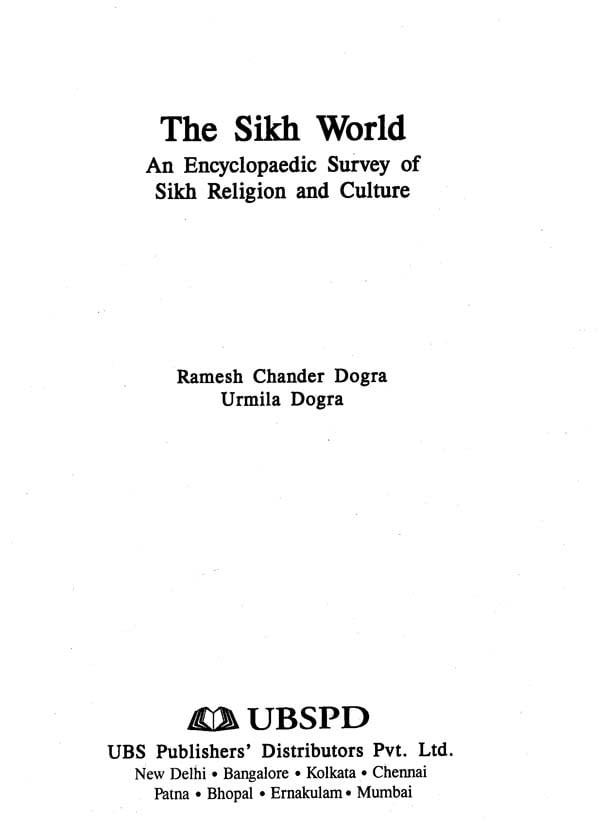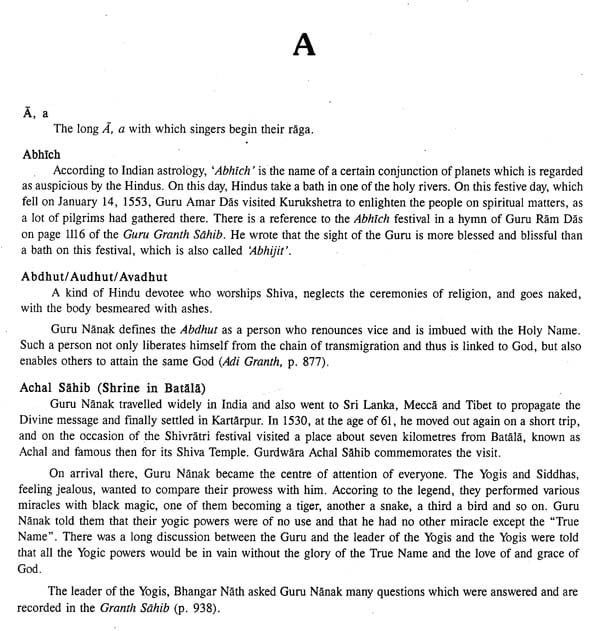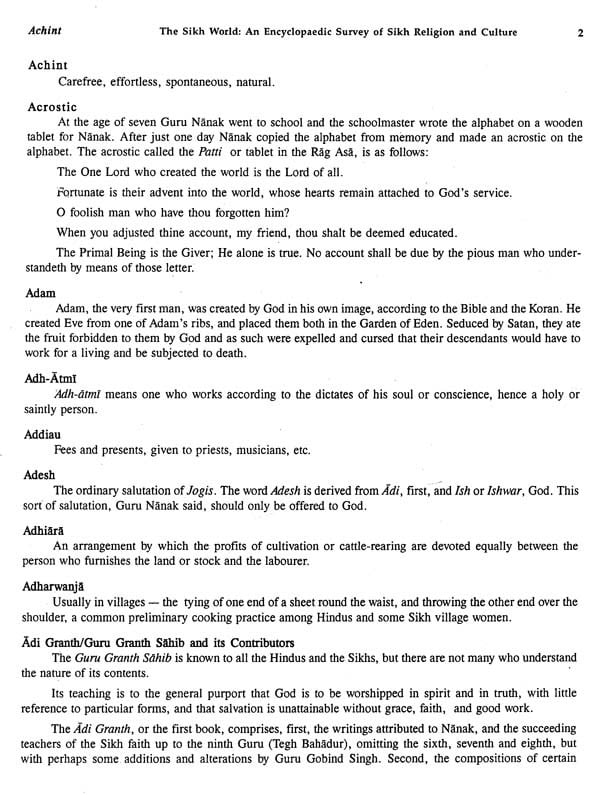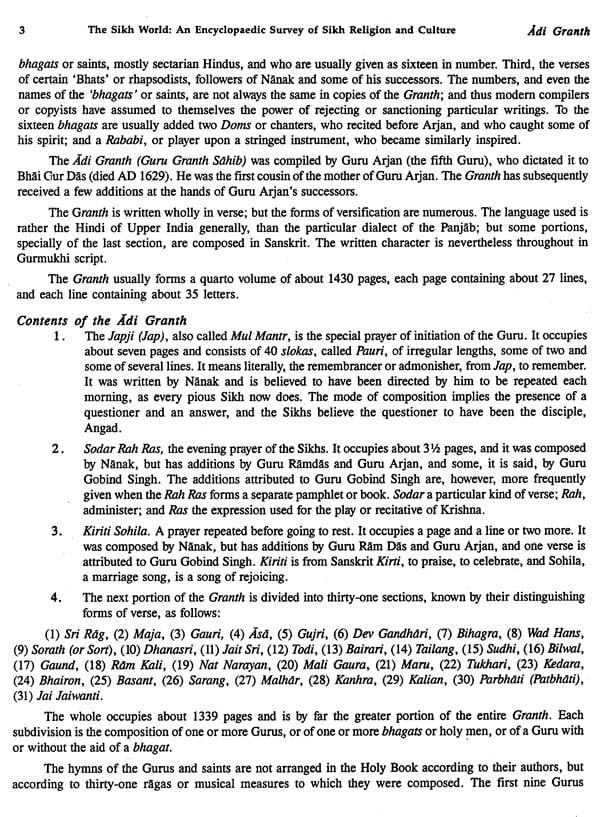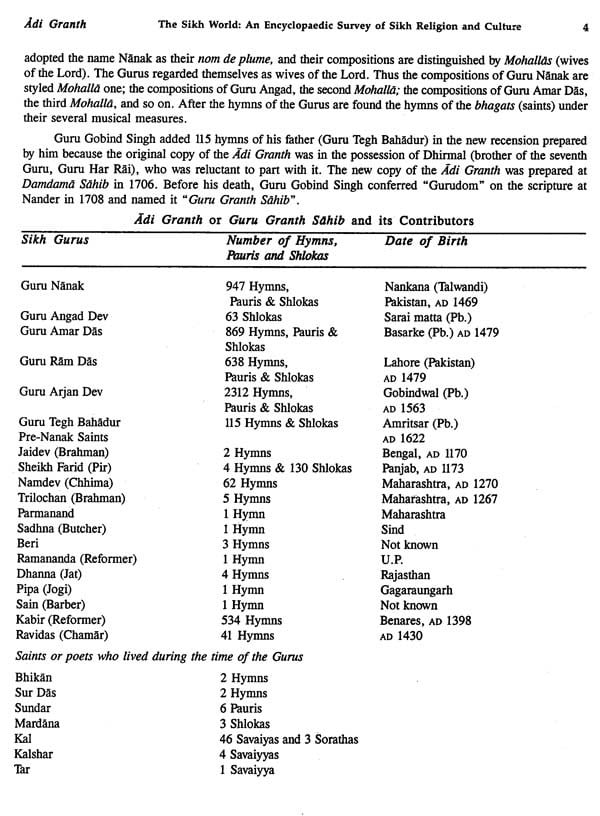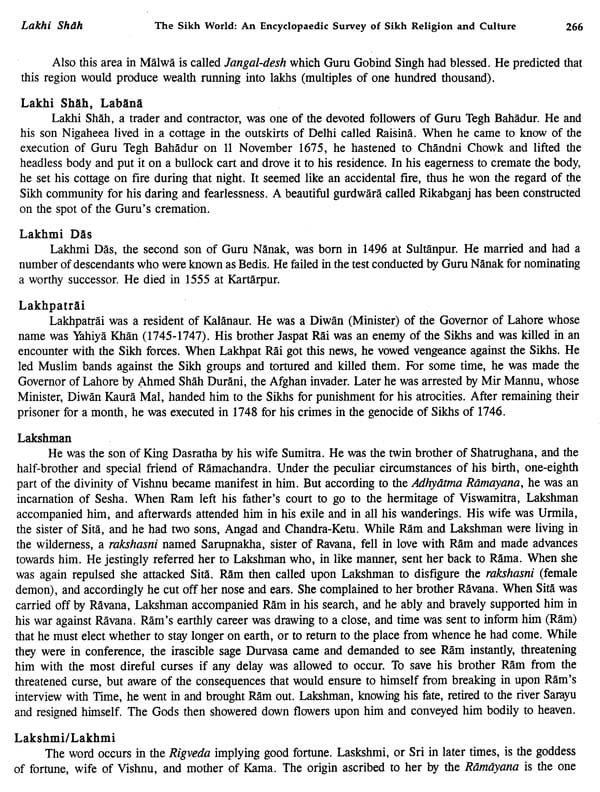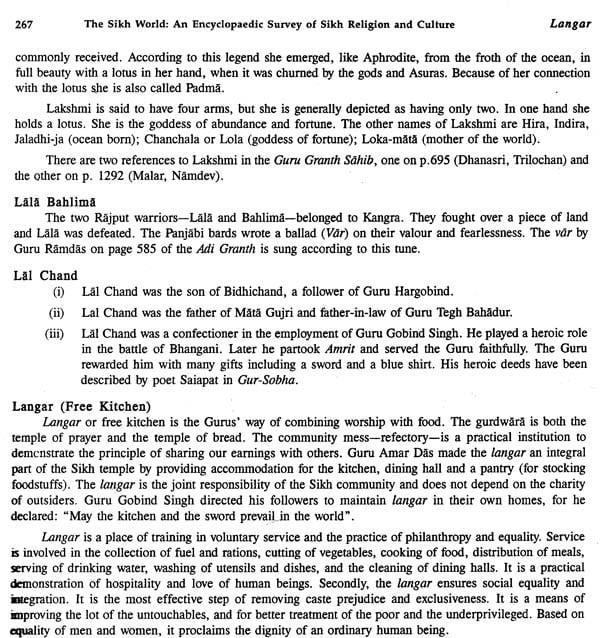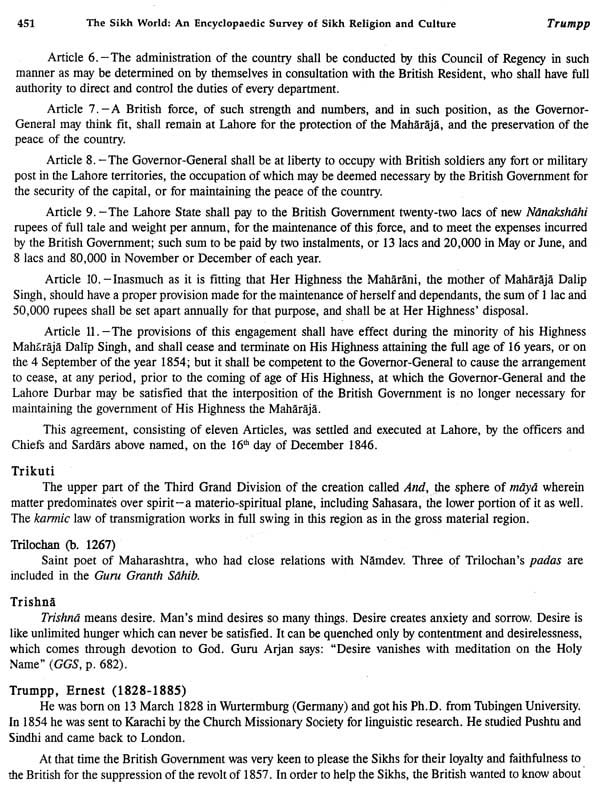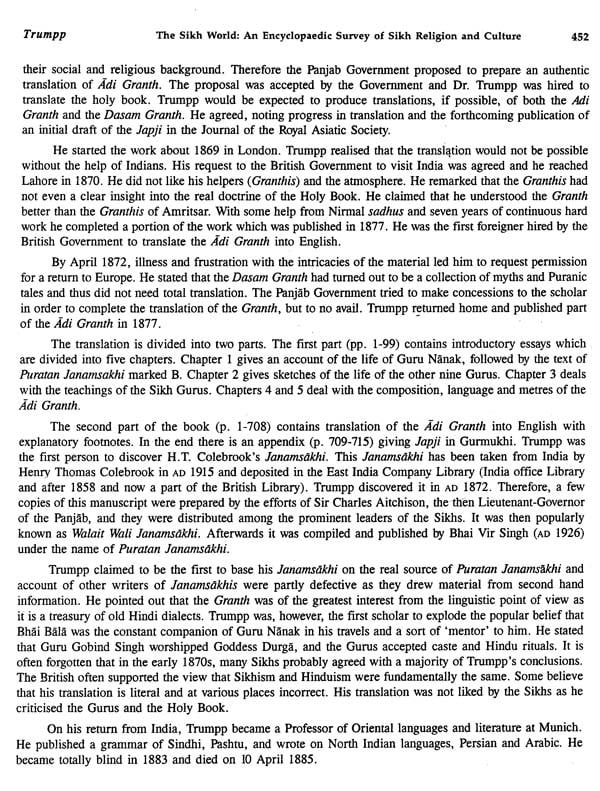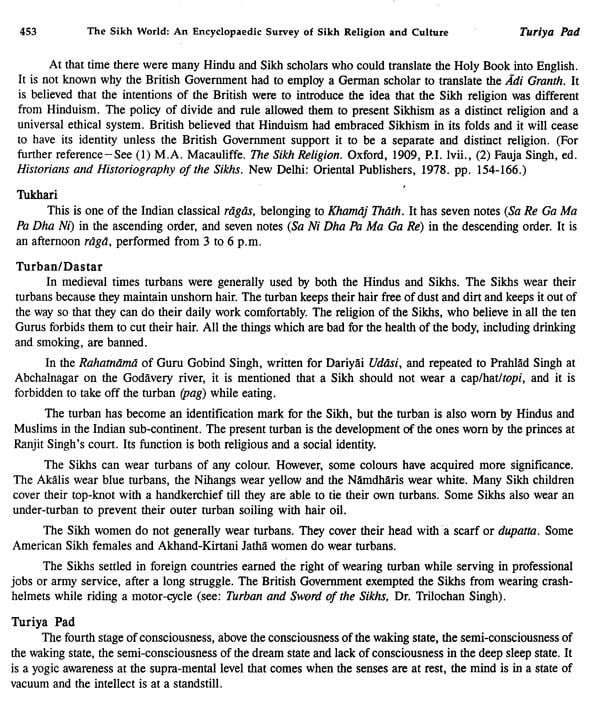
The Sikh World: An Encyclopaedic Survey of Sikh Religion and Culture
Book Specification
| Item Code: | AZI108 |
| Author: | Ramesh Chander Dogra and Urmila Dogra |
| Publisher: | UBS PUBLISHER’S DISTRIBUTORS P |
| Language: | English |
| Edition: | 2006 |
| ISBN: | 9788174764430 |
| Pages: | 522 |
| Cover: | Hardcover |
| Other Details | 10.00x7.50 inches |
| Weight | 1.11 kg |
Book Description
The Encyclopedia of Sikh Religion and culture was first published in 1995, and the response from the Press, students and readers far exceeded our expectations This prompted us to revisit the old test revise and enlarge it, and the result is the new second edition titled The Sikh World An Encyclopedic Survey of Sikh Religion and culture that makes an attempt to cover the entire field of the Sikh religion.
The title of the second edition includes a reference to Sikh religion and culture because the adherents of Sikhism regard all the ten gurus as founders of their faith-the first five being the builders of the faith and the last five being its defenders. Before his death, Guru Gobind Singh appointed Banda Bahadur as head of the Sikh army and, for. the first time in Sikh history, he brought the country between Lahore and Jammu under the control of Sikhs. Sikh misals (clans) tried to capture Panjab, but they became the sovereign power in that part of the country during the time of Maharaja Ranjit Singh (1780-1839). The study of Sikhum needs to involve a study of their faith in its original form, which would include a systematic study of the writings, teachings and culture in which they grew and propagated their beliefs. This second edition makes an attempt to do that.
Though the first edition is the foundation on which the present volume is based, the entire text has been revised and corrected wherever necessary. The second edition has many new articles on culture, music, people connected with Sikhism, tribes, castes and folklore, and a chronology of Sikhism from Guru Nanak to modern times. It goes further than that-all the flowers, animals, birds, rivers and places mentioned in the Holy Granth find a reference in the volume.
The Sikhs are men of action, with spirit and energy. Their religion is open to all castes and creeds. They believe that God is always there with an individual to help and guide him. This belief makes them adventurous, bold and fearless. They can undertake anything honourable in the name of God, Guru and the Holy Book. The present volume gives a fairly complete picture of their religion, history and culture.
Ramesh Chander Dogra received his MPhil at the University of London and has written eleven books and twenty-five articles on many South Asian topics, particularly in the fields of Indology, Sikhism and Bhutan. He retired as Librarian (South Asian Studies), at the School of Oriental and African Studies, University of London, in September 2002. In January 2003 New Year's Honour List, in the UK, he was awarded MBE (Member of the Order of the British Empire) for his contribution to South Asian Studies.
Urmila Dogra, a retired Civil Servant in London, has been associated with the research projects of Mr Dogra since 1986. She is a co-author of four books.
The first edition of this book entitled "Encyclopedia of Sikh Religion and Culture" by RC Dogra and GS Mansukhani, was published by Vikas, New Delhi in 1995 and received a very encouraging and generous reception from the Press as well as students and readers interested in the subject. The appreciation of the first edition by the readers exceeded our expectations, and we have spared no pains to make it more useful by revising the old material and adding a lot of new material into the second edition. The second edition has been thoroughly revised and enlarged, and grown enormous in its comprehensiveness There are some reference books on some aspects of Sikhism, but there is no single work that covers the whole field, and Sikh World is the first attempt to do so.
In the title of this edition a reference to the Sikh religion and culture has been included because the adherents of that religion quite rightly regard all ten gurus as founders of their faith and culture The first five gurus were the builders of the faith and the last five gurus were defenders of the faith. Before his death Guru Gobind Singh appointed Banda Bahadur as head of the Sikh army and for the first time in Sikh history be brought the country between Lahore and Jammu under Sikh control Misals (Sikh clans) tried to capture Punjab, but the Siths became the sovereign power in the Punjab during the time of Maharaja Ranjit Singh (1780-1839) For this reason a study of Sikhism must involve a study of their faith in its original form. The study involves a systematic statement of their writings, teachings and culture in which they grew and propagated their beliefs. An attempt has been made to enter as fully as possible into the life, faith, beliefs, culture and history of the Sikhs.
In the introduction of the first edition, it was mentioned that suggestions for improvements would be welcomed with an intention to write an expanded and revised second edition. Upon the foundation of the first edition we have added in many more articles, and it may be pointed out that the entire text has been revised. enlarged and corrected with a view to clarify its information and enrich its factual contents. All the entries on the Gurus and many other articles of the first edition have been deleted and rewritten. In the second edition there are many new articles on culture, music, people connected with Sikhism, foreign historians on Sikhism, tribes, castes, folklore, Adi Granth, Dasam Granth, Sikh-Muslim relations, marriage ceremonies and customs, Sikh women, wives of Gurus, Muslim devotees, Hindu-Muslim relations and chronology of Sikhism from Guru Nanak to modern times.
Dr K S Duggal, the famous writer on Sikhism reviewed the first edition on 28 February 1995 in The Hindu, p. 19 and mentioned that he could not find the word Kasumbha/Kusumbha (safflower)-a flower mentioned in the Holy Granth We were grateful to Dr Duggal about the suggestion, and in the second edition all the flowers, animals, birds, rivers and places mentioned in the Holy Book are included.
